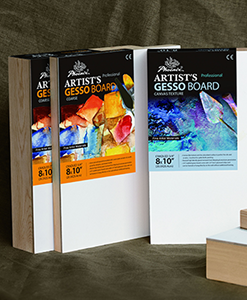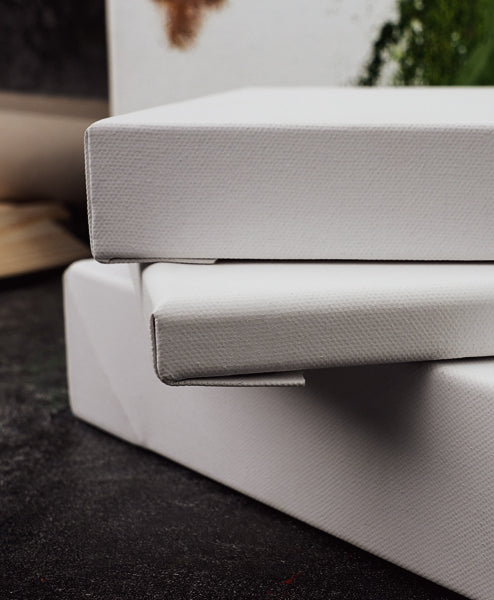Whether you’re an art school looking to equip your classrooms, a gallery preparing for an exhibition, or a wholesale buyer seeking cost-effective solutions, choosing the right canvas for watercolour can transform your creative output. Let’s explore this journey together, blending my hands-on experience with practical insights to guide your decision.
Understanding Watercolour on Canvas
Canvas isn’t the default choice for watercolour artists, who often gravitate toward paper for its absorbency. However, my initial unrolling of the Phoenix canvas roll revealed a sturdy, versatile surface that opened up new possibilities. I learned that watercolour canvas is specifically designed with a water-resistant priming to handle the fluidity of water-based paints, making it ideal for mixed media or bold, experimental works. This adaptability caught my attention, especially for bulk purchases where durability and multi-purpose use are key. I started with a small wash of crimson on the sample, and the way the colour sat on the surface—vibrant yet controlled—convinced me this could be a game-changer for art education or gallery displays.
The Right Surface: Texture and Priming
One of the first aspects I explored was the surface texture. My Phoenix canvas roll had a medium texture, which I found perfect for watercolour. It held the pigment nicely without letting it pool excessively, unlike the overly smooth stretched canvas I tested earlier, where the paint seemed to slide off. A very rough texture, on the other hand, made blending a challenge during my trial. After some research, I came across Jackson’s Art’s advice about choosing a canvas with a slight tooth, and it rang true—my medium-textured sample allowed the watercolour to grip just enough for detailed work.
Then there’s the priming, which initially baffled me. Unlike oil or acrylic canvases, watercolour canvases need a special pre-priming to balance absorbency and resistance. My Phoenix canvas was triple-primed with acrylic gesso, a detail I confirmed with their support team. I applied a light wash and noticed the paint stayed on the surface without soaking through, a stark contrast to unprimed canvas I’d seen online. This triple priming—two layers for protection and a third for smoothness—seemed tailor-made for professional use, and I could see why art schools might prefer it for student projects where longevity matters.
Weight and Strength: Finding the Sweet Spot
Canvas weight was another puzzle I had to solve. The Phoenix canvas roll I received was 300gsm, which felt substantial when I handled it. I painted a few layers of watercolour and was impressed by how it held up without warping, unlike a lighter 200gsm sample I tested that buckled under heavy washes. For wholesale buyers, weight is crucial—300-400gsm offers the strength needed for repeated use or stretching into larger formats. I stretched a 1m section myself and noticed the heavier weight maintained its shape, a big advantage for storing bulk rolls or preparing stretched canvases for exhibitions. Lighter weights might suit quick sketches, but for B-end durability, I’d lean toward the higher end.
Stretched vs. Roll Canvas: Weighing the Options
Choosing between stretched canvas and a canvas roll was a decision point for me. The stretched canvases I ordered were a breeze—ready to paint straight away—but the canvas roll opened up a world of flexibility. I cut a 1m piece from my Phoenix roll, stretched it over a wooden frame, and found the process surprisingly satisfying. For art schools, a roll allows you to custom-cut sizes for different class projects, saving costs on pre-stretched options. Galleries, however, might prefer stretched canvases for immediate display readiness. My experience suggests stocking both: rolls for bulk versatility and stretched canvases for convenience, depending on your client base.
Practical Tips from My Experiments
My time with watercolour on canvas taught me some hands-on lessons that could benefit wholesale buyers:
Sealing the Edges: I sealed the edges of my stretched canvas with masking tape to stop paint from seeping underneath—a must for a polished look in professional settings.
Layering Technique: I started with light washes, waiting for each layer to dry, which worked beautifully on the primed surface. This technique could help students build confidence layer by layer.
Storage Solutions: I learned to keep the canvas roll in a dry, cool place after a damp corner of my sample showed slight discolouration. Phoenix’s team recommended vacuum-sealed storage for bulk orders, a tip I’ll pass on.
Cleaning Up: Spills happened during my tests, but a damp cloth cleaned the primed surface easily, a practical plus for shared classroom use.
Matching Canvas to Watercolour Techniques
As I experimented, I discovered how canvas interacts with different watercolour techniques. For wet-on-wet blending—where I flooded the surface with colour—the triple-primed canvas held the flow without over-saturating, unlike paper that often buckles. For dry brush effects, the medium texture added a pleasing roughness, which I found appealing for textured landscapes. I also tried masking fluid, and it peeled off cleanly, suggesting this canvas could handle mixed media workshops. For wholesale buyers, offering canvases that support these techniques could meet diverse client needs, from beginner classes to advanced gallery pieces.
Why It Matters for Wholesale Buyers
My journey highlighted the importance of canvas choice for bulk orders. Art schools need durable, pre-primed canvases to withstand student handling, while galleries require stretched versions that meet exhibition standards. The Phoenix 300gsm triple-primed canvas roll stood out for its adaptability—perfect for cutting into custom sizes or stretching for display. I also appreciated the environmental angle; their use of FSC-certified materials Sustainability Insight aligns with growing demand for eco-friendly supplies. With Phoenix’s 15-year track record Company History and recent government recognition for cross-border trade Government Recognition, their authority adds a layer of trust for B-end clients.
Sourcing and Cost Considerations
Cost is a big factor for wholesale buyers, and I dug into this aspect too. A 100m roll of 300gsm Phoenix canvas might cost more upfront than paper, but its reusability and durability offset the expense over time. I calculated that cutting a roll into 50 2m sections could supply a semester’s worth of projects for a mid-sized art school, beating the per-unit cost of stretched canvases. For galleries, investing in pre-stretched canvases might be worth it for immediate use, but rolls offer long-term savings.
My adventure with watercolour on canvas has been a revelation. From understanding texture and priming to weighing the pros and cons of rolls versus stretched canvases, every detail shapes the outcome. For wholesale buyers, I recommend starting with Phoenix’s 300gsm triple-primed canvas roll for its versatility and strength, complemented by stretched options for display needs. The process of stretching my own piece gave me a sense of control, and the quality reassured me of its value. Reach out to Phoenix for a tailored quote, and let’s equip your next watercolour project with the best canvas available. I’m excited to see where this journey takes us next!











